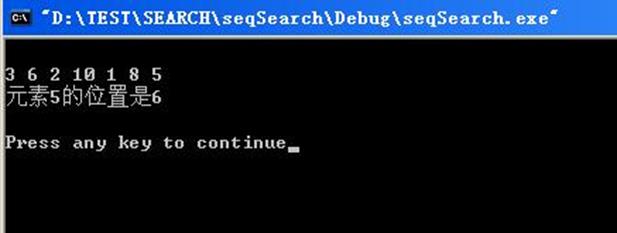C++查找实验
Posted 康小庄
tags:
篇首语:本文由小常识网(cha138.com)小编为大家整理,主要介绍了C++查找实验相关的知识,希望对你有一定的参考价值。
1.顺序查找
运行结果如图所示:

seqSearch.cpp
#include <stdio.h>
//定义表中最多记录个数
#define MAXL 100
typedef int KeyType;
typedef char InfoType[10];
typedef struct
//KeyType为关键字的数据类型
KeyType key;
//其他数据
InfoType data;
NodeType;
//顺序表类型
typedef NodeType SeqList[MAXL];
//顺序查找算法
int SeqSearch(SeqList R, int n, KeyType k)
int index = 0;
for (int i = 0; i < n; i++)
if (R[i].key == k)
index = i;
printf("%d ", R[i].key);
return index;
int main()
SeqList R;
int n = 10;
KeyType k = 5;
int a[] = 3, 6, 2, 10, 1, 8, 5, 7, 4, 9;
int i;
//建立顺序表
for (i = 0; i < n; i++)
R[i].key = a[i];
printf("\\n");
if ((i = SeqSearch(R, n, k)) != -1)
printf("\\n元素%d的位置是%d\\n", k, i);
else
printf("\\n元素%d不在表中\\n", k);
printf("\\n");
运行截图

2. 折半查找
运行结果如图所示:

binSearch.cpp
#include <stdio.h>
//定义表中最多记录个数
#define MAXL 100
typedef int KeyType;
typedef char InfoType[10];
typedef struct
//KeyType为关键字的数据类型
KeyType key;
//其他数据
InfoType data;
NodeType;
//顺序表类型
typedef NodeType SeqList[MAXL];
//二分查找算法
int BinSearch(SeqList R, int n, KeyType k)
int low = 1;
int high = n;
int count = 1;
int res = 0;
while (low <= high && count < 4)
int mid = (low + high) / 2;
if (count < 3)
printf("第%d次查找:在[%d,%d]中查找到元素R[%d]:%d\\n", count, low - 1, high - 1, mid - 1, R[mid - 1].key);
if (k == R[mid].key)
res = mid;
high = n;
low = R[mid].key;
count++;
printf("第%d次查找:在[%d,%d]中查找到元素R[%d]:%d\\n", count, low - 1, high - 1, res, R[res].key);
else if (k < R[mid].key)
high = mid - 1;
else
low = mid + 1;
count++;
return res;
int main()
SeqList R;
KeyType k = 9;
int a[] = 1, 2, 3, 4, 5, 6, 7, 8, 9, 10, i, n = 10;
//建立顺序表
for (i = 0; i < n; i++)
R[i].key = a[i];
printf("\\n");
if ((i = BinSearch(R, n, k)) != -1)
printf("元素%d的位置是%d\\n", k, i);
else
printf("元素%d不在表中\\n", k);
printf("\\n");
运行截图

3. 二叉排序树的基本运算
运行结果如图所示:

BST.cpp
#include <stdio.h>
#include <malloc.h>
#define MaxSize 100
//定义关键字类型
typedef int KeyType;
typedef char InfoType;
//记录类型
typedef struct node
//关键字项
KeyType key;
//其他数据域
InfoType data;
//左右孩子指针
struct node *lchild;
struct node *rchild;
BSTNode;
//全局变量,用于存放路径
int path[MaxSize];
//函数说明
void DispBST(BSTNode *b);
//在以*p为根结点的BST中插入一个关键字为k的结点
int InsertBST(BSTNode *&p, KeyType k)
//原树为空, 新插入的记录为根结点
if (p == nullptr)
p = (BSTNode *) malloc(sizeof(BSTNode));
p->key = k;
p->lchild = p->rchild = nullptr;
return 1;
else if (k == p->key)
return 0;
else if (k < p->key)
//递归调用,插入到*p的左子树中
return InsertBST(p->lchild, k);
else
//递归调用,插入到*p的右子树中
return InsertBST(p->rchild, k);
//由数组A中的关键字建立一棵二叉排序树
BSTNode *CreatBST(KeyType A[], int n)
//初始时bt为空树
BSTNode *bt = nullptr;
int i = 0;
while (i < n)
//将A[i]插入二叉排序树T中
if (InsertBST(bt, A[i]) == 1)
printf(" 第%d步,插入%d: ", i + 1, A[i]);
DispBST(bt);
printf("\\n");
i++;
//返回建立的二叉排序树的根指针
return bt;
//以括号表示法输出二叉排序树bt
void DispBST(BSTNode *bt)
if (bt != nullptr)
printf("%d", bt->key);
if (bt->lchild != nullptr || bt->rchild != nullptr)
printf("(");
DispBST(bt->lchild);
if (bt->rchild != nullptr)
printf(",");
DispBST(bt->rchild);
printf(")");
//以递归方式输出从根结点到查找到的结点的路径
int SearchBST(BSTNode *bt, KeyType k)
printf("%d ", bt->key);
if (k == bt->key)
return bt->key;
else if (k < bt->key)
return SearchBST(bt->lchild, k);
else if (k > bt->key)
return SearchBST(bt->rchild, k);
//当被删*p结点有左右子树时的删除过程
void Delete1(BSTNode *p, BSTNode *&r)
BSTNode *s;
BSTNode *q;
q = p;
s = p->lchild;
while (s->rchild)
q = s;
s = s->rchild;
p->key = s->key;
if (q != p)
q->rchild = s->lchild;
else
q->lchild = s->lchild;
delete s;
/*
if (r->rchild != nullptr)
Delete1(p, p->lchild); //递归找最右下结点
else //找到了最右下结点*r
p->key = r->key; //将*r的关键字值赋给*p
q = r;
r = r->lchild; //将*r的双亲结点的右孩子结点改为*r的左孩子结点
free(q); //释放原*r的空间
*/
//从二叉排序树中删除*p结点
void Delete(BSTNode *&p)
BSTNode *q;
//*p结点没有右子树的情况
if (p->rchild == nullptr)
q = p;
p = p->lchild;
free(q);
else if (p->lchild == nullptr) //*p结点没有左子树的情况
q = p;
p = p->rchild;
free(q);
else //*p结点既有左子树又有右子树的情况
Delete1(p, p->lchild);
//在bt中删除关键字为k的结点
int DeleteBST(BSTNode *&bt, KeyType k)
//空树删除失败
if (bt == nullptr)
return 0;
else
//小于说明在左边
if (k < bt->key)
//递归在左子树中删除关键字为k的结点
return DeleteBST(bt->lchild, k);
else if (k > bt->key)
//递归在右子树中删除关键字为k的结点
return DeleteBST(bt->rchild, k);
else //k=bt->key的情况
//调用Delete(bt)函数删除*bt结点
Delete(bt);
return 1;
int flag = true;
int prev=-256;
bool isBinaryTree(BSTNode *&bt)
if (bt->lchild != nullptr && flag)
isBinaryTree(bt->lchild);
if(bt->data<prev)
flag= false;
if(bt->rchild!= nullptr&&flag)
isBinaryTree(bt->rchild);
return flag;
//predt为全局变量,保存当前结点中序前趋的值,初值为-∞
KeyType predt = -32767;
int main()
BSTNode *bt;
KeyType k = 6;
int a[] = 4, 9, 0, 1, 8, 6, 3, 5, 2, 7, n = 10;
/*
4
/ \\
0 9
\\ /
1 8
\\ /
3 6
/ /\\
2 5 7
*/
printf(" 创建一棵BST树:");
printf("\\n");
bt = CreatBST(a, n);
printf("\\n\\n BST: ");
DispBST(bt);
printf("\\n\\n");
printf(" 查找%d关键字: ", k);
SearchBST(bt, k);
printf("\\n\\n");
printf(" 是否是二叉排序树: \\n");
if(isBinaryTree(bt))
printf(" 是二叉排序树 \\n");
else
printf(" 不是二叉排序树 \\n");
printf("\\n\\n 删除操作:\\n");
printf(" 原BST: ");
DispBST(bt);
printf("\\n");
printf(" 删除结点4: ");
DeleteBST(bt, 4);
DispBST(bt);
printf("\\n");
printf(" 删除结点5: ");
DeleteBST(bt, 5);
DispBST(bt);
printf("\\n\\n");
运行截图

4.自行设计一个算法,判别给定的一棵二叉树是否为二叉排序树
根据第三题结构,添加如下算法代码
#include <stdio.h>
#include <malloc.h>
#define MaxSize 100
//定义关键字类型
typedef int KeyType;
typedef char InfoType;
//记录类型
typedef struct node
//关键字项
KeyType key;
//其他数据域
InfoType data;
//左右孩子指针
struct node *lchild;
struct node *rchild;
BSTNode;
//全局变量,用于存放路径
int path[MaxSize];
//函数说明
void DispBST(BSTNode *b);
//在以*p为根结点的BST中插入一个关键字为k的结点
int InsertBST(BSTNode *&p, KeyType k)
//原树为空, 新插入的记录为根结点
if (p == nullptr)
p = (BSTNode *) malloc(sizeof(BSTNode));
p->key = k;
p->lchild = p->rchild = nullptr;
return 1;
else if (k == p->key)
return 0;
else if (k < p->key)
//递归调用,插入到*p的左子树中
return InsertBST(p->lchild, k);
else
//递归调用,插入到*p的右子树中
return InsertBST(p->rchild, k);
//由数组A中的关键字建立一棵二叉排序树
BSTNode *CreatBST(KeyType A[], int n)
//初始时bt为空树
BSTNode *bt = nullptr;
int i = 0;
while (i < n)
//将A[i]插入二叉排序树T中
if (InsertBST(bt, A[i]) == 1)
printf(" 第%d步,插入%d: ", i + 1, A[i]);
DispBST(bt);
printf("\\n");
i++;
//返回建立的二叉排序树的根指针
return bt;
//以括号表示法输出二叉排序树bt
void DispBST(BSTNode *bt)
if (bt != nullptr)
printf("%d", bt->key);
if (bt->lchild != nullptr || bt->rchild != nullptr)
printf("(以上是关于C++查找实验的主要内容,如果未能解决你的问题,请参考以下文章